WARNING: To avoid scalding yourself from hot coolant or steam, take extra care when removing the coolant expansion tank seal when the cooling system is warm. Allow the engine to cool, then wrap a thick cloth around the expansion tank cap and slowly unscrew it until pressure build-up begins. Step back while depressurizing the cooling system. After making sure that the pressure is completely relieved, and without removing the cloth, turn and remove the sealed cap of the coolant expansion tank. Failure to follow these instructions may result in injury.
To prevent corrosion and engine damage from freezing coolant, fill the engine cooling system with the correct grade of antifreeze at the correct concentration. Failure to do so may result in vehicle damage.
The coolant can damage the paintwork. If you spill coolant, remove it immediately and flush the area with water.
1. Set heater controls to maximum heat (NOT).
2. Turn away a cover of a broad tank.
WARNING: Do not remove the coolant expansion tank cap when the system is hot, as steam or coolant escaping from the cap could cause serious injury such as scalding.
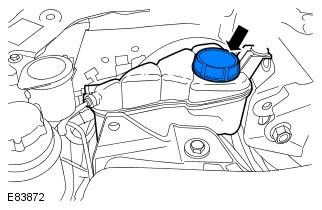
3. Raise the car and place it on supports.
WARNING: Do not work on or under a vehicle supported only by a jack. Always place secure supports under the vehicle.
4. Remove the motor protection. Refer to procedure: Motor protection (501-02 Front body panels, Removal and installation).
5. Remove the right front mudguard.
NOTE: Wheel shown removed for clarity.
6. Place a container to collect liquid.
7. Connect hose to radiator drain cock.
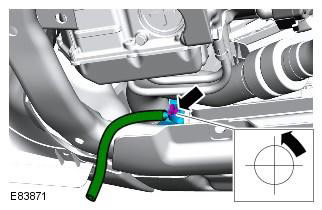
8. Open the radiator drain cock.
9. Drain the coolant from the radiator.
10. Remove the drain plug.
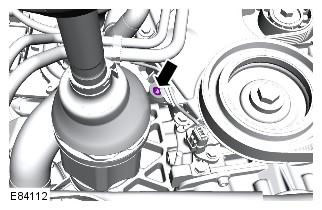
11. Drain the engine coolant.
12. Close the radiator drain cock and remove the hose.
13. Screw in the drain plug. Tightening torque: 23 Nm
14. Prepare a sufficient amount of coolant of the required concentration.
15. Install the vacuum filling adapter of the cooling system on the expansion tank.
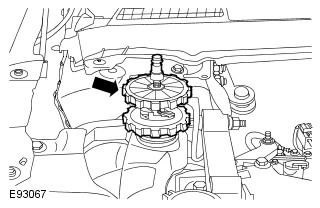
16. Install the vacuum filling gauge on the cooling system charging adapter.
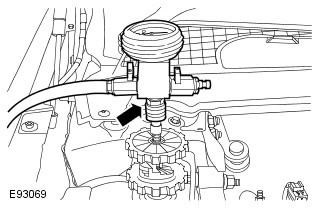
17. Install the venturi assembly on the measuring device of the vacuum filling device.
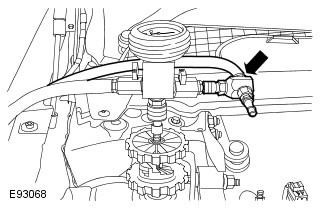
18. Connect the regulated air supply line to the venturi assembly.
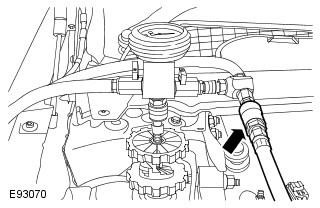
19. Place the coolant pickup tube in a container of clean coolant.
NOTE: Make sure there is no air in the hose.
20. Place an air evacuation hose into the container.
21. Open the air supply valve.
NOTE: Make sure the coolant supply valve on the vacuum filler gauge is in the closed position.
NOTE: The vacuum tool requires an air pressure of 6 to 8 bar to charge the coolant properly.
NOTE: Small diameter or long air lines may restrict airflow to vacuum coolant charging tool.
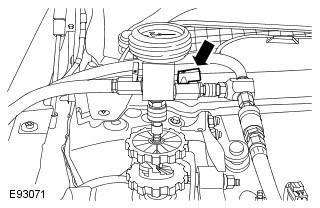
22. Open the coolant supply valve for 2 seconds to fill the coolant hose.
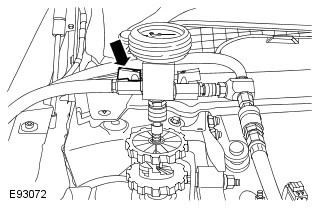
23. Apply air pressure gradually until the pointer on the gauge on the vacuum filler reaches the green segment.
24. Close the air supply valve.

25. Wait 1 minute to make sure the vacuum is maintained.
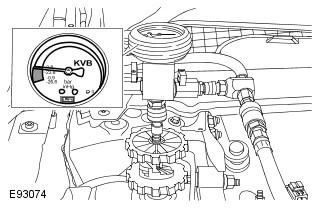
26. Disconnect the compressed air supply line.
27. Open the coolant supply valve to prime the system with coolant.
NOTE: When the coolant reaches the upper mark (MAX) expansion tank or coolant stops flowing, close the coolant supply valve.
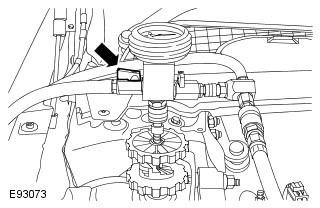
28. Remove the vacuum fill gauge and coolant charge adapter assembly.
29. Connect hoses for removal of the fulfilled gases to back exhaust pipes.
30. Start the engine and let it run.
31. Establish a cover of a broad tank of system of cooling.
32. Keep the engine speed at 2000 rpm until warm air comes out of the heater.
33. Turn off the engine and let it cool down.
34. If the car gets coolant, wipe it off.
35. Check the coolant level, top up if necessary.
WARNING: Because steam or coolant leaks can cause burns, allow the vehicle's cooling system to cool before performing this procedure.
36. Install the right front mudguard.
37. Install engine protection. Refer to procedure: Motor protection (501-02 Front body panels, Removal and installation).
Comments on this article